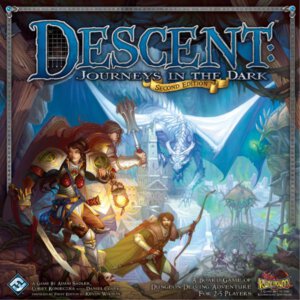
Publisher: Fantasy Flight Games
Designers: Daniel Clark, Corey Konieczka, Adam Sadler, and Kevin Wilson
Year: 2012
Genre: Fantasy adventure boardgame with miniatures and RPG elements
Players: Two to five players
Ages: 14+
Playing Time: 30 to 120 minutes
MSRP: $79.95
I’m an old hat at playing Descent. It is the one dungeon crawl game that my kids have really liked. I was a bit leery when I found out that Fantasy Flight Games was releasing a second edition of the game. Would it make my original game and the expansions obsolete? Will there be no more expansions to the original? Why is the box only half of the size of the original game? Will they change the gameplay and screw up the game? I was concerned and I had a right to be, as I had invested a lot of time and money into the original Descent and its expansions.
I have now played Descent: Second Edition multiple times, and I have to say that I have found it a million times better than the original Descent.
For starters, the reason that the box is so small compared to the original game is because FFG has managed to streamline the game in a way that has eliminated two-thirds of the tokens you need to play. It is true that there are fewer monsters in the box, and fewer heroes as well. Since they are already coming out with the first expansion soon, I don’t think you’ll find it wanting.
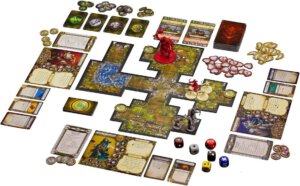
Then there are the monster cards. I can’t remember how it is handled in the original, but now you get two monster cards per monster group. Act I and Act II monsters. The act II monsters don’t even come into the game until you start going into the full campaign. Yes, that’s right. There is a full campaign included with this edition, unlike the original game where you had to pick up the “Road to Legend” expansion before you were able to advance your characters through a continuing storyline.
The monster cards are normal sized cards that have the stats for the minion monsters (the white figures) across the top, and the master monsters (the red figures) across the bottom. Each scenario tells you which monster groups the overlord will be using, and you just pull out the act I card that goes with that group. On the reverse of the card it shows you how many white and red monster figures to use depending upon the number of players. Each monster has special abilities, and they are described right on the back of the card.
The heroes are also streamlined, and yet have more options. Each hero card lists the main characteristics of the hero, and also four skill values, like willpower and knowledge, that the hero may need to pass a test on at different points in the game. If you have a willpower of four, and need to pass a willpower test, you roll the black and grey dice. If you roll equal or less than your score of four, you pass. The same dice are rolled to pass any skill test. It’s very simple.
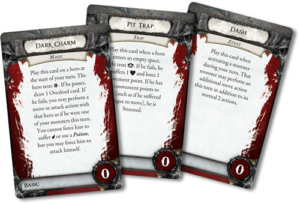
Also gone are all of the coin tokens. Now each treasure you find or item you buy is worth a certain amount of gold, that you can sell between encounters when playing the campaign. Some quests also reward you with gold. You keep track on the pad of campaign sheets included, and players can freely share gold between each other. Each encounter shows the location where you place search tokens on the map. When a player searches that area, they can draw an item from the search stack and gain a valuable item. There is also a stack of items that can be purchased in the shop, and some unique items available as rewards in certain quests.
There are four hero classes, and each class has two decks of special abilities that they can choose from. For example, if you choose one of the warrior heroes, you can either choose the Knight deck or the Berserker deck to use with your hero. The deck has your starting weapons and ability in it. As you earn experience, you can spend it to buy additional abilities out of the deck for future encounters. It’s really cool and lets you customize your hero as you adventure.
The Overlord has the same option. He starts with a basic set of overlord cards, and then can spend experience earned to buy additional cards to add to his deck. He may customize his deck this way, and add or subtract from it before an encounter. The only rule is that the deck must contain at least 15 cards. It adds a bit of a deck building feel for the Overlord and is pretty sweet.
There are over thirty encounters included. Most quests involve two-encounters, and each encounter generally lasts about an hour. It’s a lot faster than the original Descent, where you could spend four hours playing one simple adventure. The narrative is still there, and with the included campaign pad all you need to do to is toss all of your hero’s stuff in a baggie and put the game away. The next time you play you just grab your hero’s baggie of cards, lay them out, and you are ready to play the next encounter.
What is really interesting is that the campaign can evolve into different encounters depending upon whether the players or the overlord won the last adventure. There is a chart used to determine which adventure in the campaign you will face next. So one campaign might play out completely differently than another campaign. They also have event cards you use with the campaign, so that random things can happen while you are traveling between adventures on the campaign map on the back of the quest guide. This is also a nice touch.
The map tiles are double sided. Generally one side is an outdoor scene, and the other is a traditional dungeon or castle scene. These 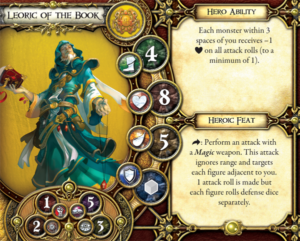
The line of sight rules have been simplified quite a bit. Basically, if you can trace a line from any corner of the square you are in to any corner of the target’s square without being blocked, then you have line of sight.
Each turn every hero gets two actions to spend. You can move, attack, rest, search, open or close a door, revive another hero,use a skill, or stand up if you were knocked out. You can do an action twice if you want, so you can attack twice or move twice if you wish.
Attacking is easy. Your weapon card shows you which dice to roll for your attack. A hero might roll the red and blue dice to swing his sword. The dice haven’t changed much from the original game and you’ll end up rolling a certain number of hearts and surges, plus a range number. The hearts represent the amount of damage you do, the range number is added together and this tells you how far you were able to shoot your ranged weapon. If the target is six squares away, but you only rolled a range of five, then you missed. The surges are still in the game, but they are used differently. Your hero card, weapons, and special abilities each might display the surge icon and what it can be used for. You might be able to add extra damage, or extra range, or even some special effect by using your surges.
The defender then gets to roll their defense die to see how much damage they can avoid. Usually you’ll be rolling the grey die and will roll from one to three shields. This is the amount of damage that is canceled from the attack.
The monsters have their attack dice shown right on their card, and also have special abilities to spend surges on. They might poison a hero, or immobilize them, or any number of nasty things.
If you don’t have anything to spend a surge on, you can always use it to remove a point of fatigue from your hero. Certain skills cause you to get fatigued. This is represented by adding fatigue tokens to your hero sheet. Each hero has a fatigue value, and if you reach the max, then you cant use those skills anymore until you do a rest action to get rid of your fatigue.
The overlord gets to take his turn after the heroes do. He’ll get to move and attack with his monsters, as each monster also gets two actions to spend during the overlord’s turn. The only difference being that the monsters cannot attack twice. You keep repeating turns until either the hero’s or the overlord wins the encounter according to that encounter’s victory conditions.
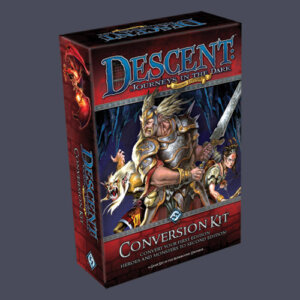
Don’t throw away your original version though, if you have one. If you pick up the Descent Conversion Kit from FFG it includes new monster and hero cards for all of the monsters and heroes in the first edition game, as well as the expansions and any promotional figures FFG ever produced. You’ll be able to use those figures with the new edition easily, so if you own the original game and expansions the conversion kit is a great option for you to add tons of content to the new second edition. I’m even tempted to buy some of the old expansions I’m missing just so that I have the figures to use in second edition.
- A Dungeon Delve for Kids?: A Review of Dungeon! - Oct 24, 2022
- Your Planet is Doomed!: Invasion from Outer Space Reviewed - Oct 22, 2022
- ‘Star Trek: Fleet Captains’ Back in Stores - Jan 21, 2013
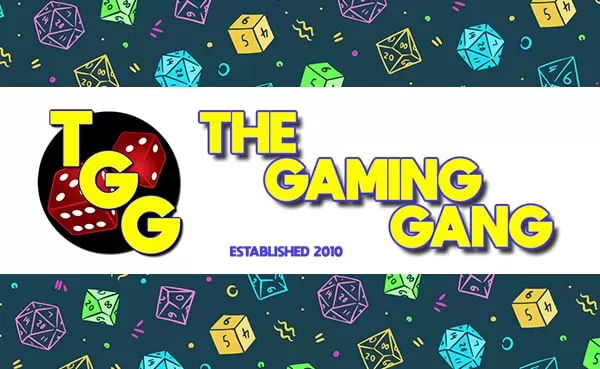


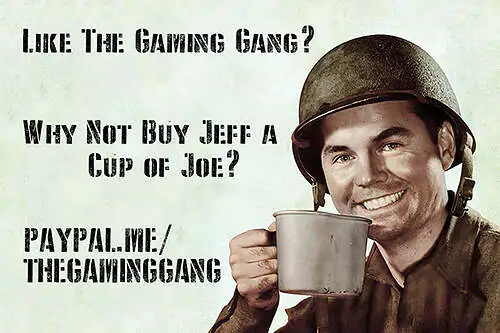






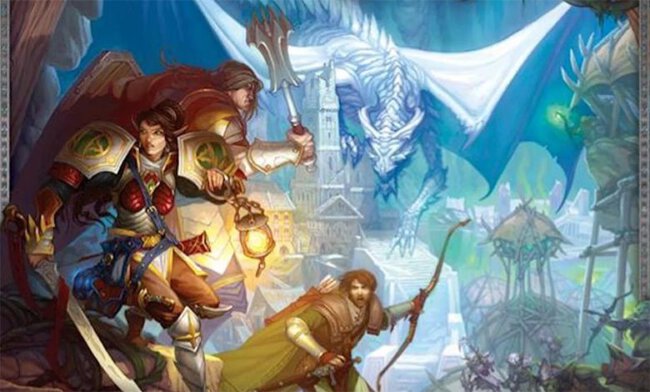




3 Comments
I own both editions of Descent and can’t understand how anyone can find the second edition more appealing. If you want a game where it is impossible to win as a hero and always want to feel rushed then the second edition is perfect. I’m not the best gamer but with a halfway decent grasp of tactics as the overlord you can never lose. I’ve never had the hero party even come close to winning a single game. The other second edition gripe is that the whole board is set up from the start which gives no real feeling of mystery as you delve into a dungeon you have never seen before. Instead of calling it streamlined I would use the term “dumbed down” for those with little patience and lack of full commitment to a game that was balanced. The first edition is a little time consuming and full of pieces but that’s a ton of the appeal! Too many original games are being replaced with “dumbed down” versions so that they can appeal to a younger crowd or a crowd that can’t sit still and read a few more pages of instructions. Fantasy Flight has recently been notorious for pulling fantastic games that have been a huge hit for years and replacing them with editions of the same game that resembles something that Parker Brothers would release for family game night.
I have to admit I only played the second edition once (Elliott provided this review) and I wasn’t overly thrilled with it myself. I too felt it was unbalanced as far as the heroes being able to win but chalked it up to only playing the first scenario. It was pointed out to me the game got better with other adventures but honestly, we had other games on the agenda I was much more interested in tackling so we only played the one session.
Yeah, and people would not like it versus on the original version. People that would be buying this are dumb and stupid coz, who would buy a game that is impossible to win as hero. And the maps are tiny compared to the original and would just finish in half the time as the original is. And at a level that the Parker Brothers would release for a family game night that only casual people would play. Very sure it would flop and would receive very negative reviews and no one would like it. The original would be brought back and the this 2nd edition would be scrapped due to overwhelming demand. No more expansions would be made and this version would be forgotten.